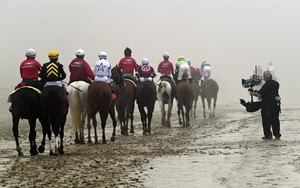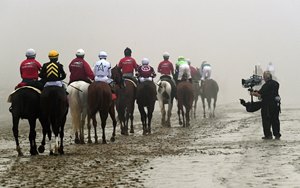NBC Finds Way at Foggy Preakness Stakes


Thanks to fog blanketing Pimlico Race Course, there is a moment where Justify and Good Magic disappear from sight as they turn for home during NBC Sports' coverage of the Preakness Stakes (G1).
But thanks to plenty of options in terms of cameras as well as production adjustments on the fly by NBC, most of the 1 3/16-mile race May 19 at Pimlico is visible. Because NBC found a way to film the top contenders for most of the race, that moment the top two contenders vanished into the fog, followed by a few seconds of shadows emerging from gray, served only to build suspense for viewers, as they waited to see if Justify had held his advantage.
"It was a really tough show, and it was as weird a sensation I've had as a producer in my 21 years at NBC," said coordinating producer of NBC Sports horse racing coverage Rob Hyland.
While the fog-dimmed spectacle of impressive Kentucky Derby Presented by Woodford Reserve (G1) winner Justify battling to a second classic win played out on the Pimlico track, there was nearly as much drama taking place in the NBC Sports production trailer. Without a lighthouse in sight, NBC would find a way.
As the fog swallowed the track in the late afternoon, NBC Sports' traditional pan and iso cameras were rendered useless for the Preakness. Those cameras have to be high enough to get angles for the shots but any cameras at those heights found themselves in the fog's belly.
As horses moved into the gate for the Preakness, NBC relied on the helmet camera of on-horseback commentator Donna Brothers.
"She was right next to them, no one else could see them," Hyland noted.
As the gates opened, the production moved to a hand-held camera, which Hyland said had never been used for a race start.
"Literally, it was the only camera where you could see the start gate," Hyland said. "The fog was that thick."
As horses came under the wire the first time, NBC shifted to a camera it has in place to use for super slow motion footage of race finishes. But with many of its regular cameras left useless, the slow-motion camera was instead used to capture the horses as they raced through the stretch the first time.
NBC Sports had shown most of the day's undercard races and the production team realized that lower camera angles were needed to have a chance of capturing any of the action. The slow motion camera would linger on the horses going by a bit longer than usual, then a camera in the middle of the first turn would pick up the race.
In terms of covering the action in the backstretch, NBC Sports had picked a good year to add its "Bat Cam," which uses a cable about 18 feet above the action to follow along with the horses. That camera would take viewers pretty much from out of the first turn and into the far turn, picking up the action as well as the backstretch barns, their roofs veiled by the fog.
"Thank goodness that we added this two-point cable camera system for the Triple Crown this year called Bat Cam, which essentially covered the entire backstretch of the race," Hyland said. "Then the horses went into the fog for about two seconds, and they came out of the fog to another, really low angle shot that typically we would never use in a race cut. And they eventually went away from that camera."
That's when NBC Sports returned to the camera that had been intended for the super slow-motion finish. Its memorable shot only showing fog for an instant, then shadows, then shadows taking shape, then viewers would soon clearly see that Justify had retained his advantage as he entered midstretch.
Video
Hyland credited director Pierre Moossa as well as all of the cameramen and crew for finding a way.
"It was all improvised and sort of rehearsed during commercial breaks based on what can we actually see and what we can show the viewers to document the second leg of the Triple Crown," Hyland said.
NBCSN served up early races on the card before coverage shifted to NBC at 5 p.m. As they were getting ready to move coverage to NBC, Hyland had noticed the thickening fog.
"I looked over at Pierre and said, 'Hey man, this fog is going to be an issue and I think it's only going to get worse,'" Hyland said. "As we came on the air (NBC), and at every break, I kind of muttered under my breath, 'I'm a little worried about this.' I mean, think what you want of the way NBC covers horse racing events—we do a lot of the lifestyle stuff—but at the end of the day I'm a sports producer and it comes down to documenting the event.
"I love horse racing, it's part of my family, and I started to get a pit in my stomach thinking, 'Are we going to be able to cover this sporting event properly?'"
In that time, Hyland said the entire crew rose to the occasion. In the scene setter from commentator Bob Costas, NBC Sports added a shot of the fog. And in shots in and out of commercials, more shots of the fog were offered to make the adverse conditions clear to the viewer.
Analysts Randy Moss and Jerry Bailey had fun conversations with race caller Larry Collmus and at one point a camera provided Collmus's view, which was similar to the view provided when a 737 is flying through a cloud.
Hyland said that shot had him thinking of a similar shot of Al Michaels at an Atlanta Falcons at New England Patriots game last October where the fog rolled in during the second half. Like Saturday's Preakness coverage, a cable camera—SkyCam—would help save the day.
In his conversations with the analysts, Collmus acknowledged that he was relying heavily on the television feed. He certainly delivered plenty of top calls, for instance, noting Maryland Sprint Stakes (G3) winner Switzerland had shifted out of neutral.
Hyland said a pair of dirt races before the Preakness allowed some level of preparation for the big race. Moosa challenged camera operators to find new angles—lower angles—that would allow for a view of the action.
"I'm so proud of the crew, the camera operators, and the way Pierre directed them all. They were flying blind. I know it's kind of cliché to say that, but they really didn't know when these horses would emerge from the fog," Hyland said. "Their years of experience in working with us, having done dozens of Triple Crown races; they all rose to the challenge. Our technical crew is the absolute best in the business."
Hyland loves the challenge of putting together a racing production and said the crew makes it possible.
"I work on football in the fall. With all due respect to football, you're in a stadium with fixed camera locations and you're dealing with a 100-yard football field," Hyland said. "The venue at Churchill Downs alone is 140 acres and we have every inch covered. Belmont is massive. The fact we can get on and off the air despite the conditions that challenge us is really a testament to our technical operations crew."
After the foggy day in Baltimore, Hyland received a one-word text from friend and colleague Craig Silver, the CBS Sports coordinating producer for college football who earned an Emmy for coverage of the 2017 Army-Navy game in the snow in Philadelphia.
The text? "Bravo."
